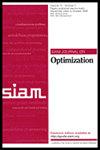双时间尺度随机优化框架在控制和强化学习中的应用
IF 2.6
1区 数学
Q1 MATHEMATICS, APPLIED
引用次数: 0
摘要
SIAM 优化期刊》,第 34 卷第 1 期,第 946-976 页,2024 年 3 月。 摘要我们研究了一种求解优化问题的新的双时间尺度随机梯度法,在该方法中,梯度是在由基础优化变量控制的时变马尔可夫随机过程产生的样本下借助辅助变量计算的。这些时变样本会使我们更新的梯度方向产生偏差和依赖性,从而可能导致迭代发散。在我们的双时间尺度方法中,一个尺度是从这些样本中估计真实梯度,然后用于更新最优解的估计值。虽然这两个迭代是同时进行的,但前者的更新(使用较大的步长)比后者(使用较小的步长)"更快"。我们的第一个贡献是描述了所提出的双时间尺度随机梯度法的有限时间复杂性。特别是,我们提供了该方法在不同结构假设(即强凸性、Polyak-Łojasiewicz 条件和一般非凸性)下的收敛率的明确公式。我们将我们的框架应用于控制和强化学习中的策略优化问题。首先,我们研究了具有有限状态和行动空间的无限视距平均回报马尔可夫决策过程,并推导出了函数近似下在线行动者批判算法的收敛率[math],这恢复了专门针对该问题推导出的已知最佳收敛率。其次,我们研究了线性二次调节器,并证明在线行动者批判方法的收敛率为 [math]。第三,我们使用行为批判算法来解决熵正则化马尔可夫决策过程中的政策优化问题,在此我们也建立了[math]的收敛性。我们对第二和第三个问题得出的结果都是新颖的,在以前的文献中是未知的。最后,我们简要介绍了我们的框架在强化学习中基于梯度的策略评估算法中的应用。本文章由计算机程序翻译,如有差异,请以英文原文为准。
A Two-Time-Scale Stochastic Optimization Framework with Applications in Control and Reinforcement Learning
SIAM Journal on Optimization, Volume 34, Issue 1, Page 946-976, March 2024.
Abstract. We study a new two-time-scale stochastic gradient method for solving optimization problems, where the gradients are computed with the aid of an auxiliary variable under samples generated by time-varying Markov random processes controlled by the underlying optimization variable. These time-varying samples make gradient directions in our update biased and dependent, which can potentially lead to the divergence of the iterates. In our two-time-scale approach, one scale is to estimate the true gradient from these samples, which is then used to update the estimate of the optimal solution. While these two iterates are implemented simultaneously, the former is updated “faster” (using bigger step sizes) than the latter (using smaller step sizes). Our first contribution is to characterize the finite-time complexity of the proposed two-time-scale stochastic gradient method. In particular, we provide explicit formulas for the convergence rates of this method under different structural assumptions, namely, strong convexity, the Polyak–Łojasiewicz condition, and general nonconvexity. We apply our framework to policy optimization problems in control and reinforcement learning. First, we look at the infinite-horizon average-reward Markov decision process with finite state and action spaces and derive a convergence rate of [math] for the online actor-critic algorithm under function approximation, which recovers the best known rate derived specifically for this problem. Second, we study the linear-quadratic regulator and show that an online actor-critic method converges with rate [math]. Third, we use the actor-critic algorithm to solve the policy optimization problem in an entropy regularized Markov decision process, where we also establish a convergence of [math]. The results we derive for both the second and third problems are novel and previously unknown in the literature. Finally, we briefly present the application of our framework to gradient-based policy evaluation algorithms in reinforcement learning.
Abstract. We study a new two-time-scale stochastic gradient method for solving optimization problems, where the gradients are computed with the aid of an auxiliary variable under samples generated by time-varying Markov random processes controlled by the underlying optimization variable. These time-varying samples make gradient directions in our update biased and dependent, which can potentially lead to the divergence of the iterates. In our two-time-scale approach, one scale is to estimate the true gradient from these samples, which is then used to update the estimate of the optimal solution. While these two iterates are implemented simultaneously, the former is updated “faster” (using bigger step sizes) than the latter (using smaller step sizes). Our first contribution is to characterize the finite-time complexity of the proposed two-time-scale stochastic gradient method. In particular, we provide explicit formulas for the convergence rates of this method under different structural assumptions, namely, strong convexity, the Polyak–Łojasiewicz condition, and general nonconvexity. We apply our framework to policy optimization problems in control and reinforcement learning. First, we look at the infinite-horizon average-reward Markov decision process with finite state and action spaces and derive a convergence rate of [math] for the online actor-critic algorithm under function approximation, which recovers the best known rate derived specifically for this problem. Second, we study the linear-quadratic regulator and show that an online actor-critic method converges with rate [math]. Third, we use the actor-critic algorithm to solve the policy optimization problem in an entropy regularized Markov decision process, where we also establish a convergence of [math]. The results we derive for both the second and third problems are novel and previously unknown in the literature. Finally, we briefly present the application of our framework to gradient-based policy evaluation algorithms in reinforcement learning.
求助全文
通过发布文献求助,成功后即可免费获取论文全文。
去求助
来源期刊

SIAM Journal on Optimization
数学-应用数学
CiteScore
5.30
自引率
9.70%
发文量
101
审稿时长
6-12 weeks
期刊介绍:
The SIAM Journal on Optimization contains research articles on the theory and practice of optimization. The areas addressed include linear and quadratic programming, convex programming, nonlinear programming, complementarity problems, stochastic optimization, combinatorial optimization, integer programming, and convex, nonsmooth and variational analysis. Contributions may emphasize optimization theory, algorithms, software, computational practice, applications, or the links between these subjects.
 求助内容:
求助内容: 应助结果提醒方式:
应助结果提醒方式:


